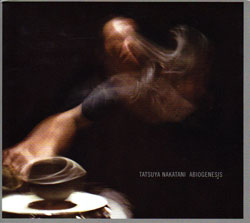
The craft of the post-instrumentalist (someone who relies on extended techniques and spends his/her time engaged in doing everything but playing his / her instrument the "right" way) mirrors that of cartoon moose Bullwinkle who, week after week, would announce "watch me pull a rabbit out of my hat", then reveal anything but a rabbit. In other words, it's about surprise and chaos ó not just for an audience, but for the performer whose pioneering use of, say, pine cones on bass drums (thank you for your work, LÍ Quan Ninh) lead from the mundane to startling, artistic excitement to variable tangents to explore onstage, back in the studio or during the next movement of a record.
Equipped with large wind gongs, some "standards" (snare, floor tom, converted bass drum) and a workstation laden with heaps of sticks, cymbals, needles, mallets, bowls and brushes, Osaka-born / Pennsylvania based post-percussionist, early Japanese folk music obsessive and free jazz drummer (he has standing gigs with Michel Doneda, bassist Peter Jacquemyn, guitarist David Stackenšs etc.) Tatsuya Nakatani is this brand of musical magician who manages, caresses and sometimes hacks through his accouterment to coax new from the obvious ó and, most importantly, alchemizing all potential novelty into compelling music.
During the fifteen tracks, Nakatani recurrently plays with the theme of bowed gongs. Though the idea is not necessarily unfamiliar, the artist displays a knowledge and method of intimate focus that is wholly anomalous. Beginning the first work with a trance-inducing atmosphere, Nakatani's bow meets gong to birth an elegant swirling exhale of distant thunder and polyphony of pitches and harmonics; his further elaborations on this gesture invoke everything from Siren Song to mournful wails (sic) to passing jets to static whirs (all of these visions appearing as supernaturally emotive and rife with tension).
But this is only one of Nakatani's facets. For track two, he hollows out the middle frequencies, tapping a spacious funeral parade pulse on bass drum while forming a ringing melody with various prayer bowls. He follows with rubber tubes blown and drug across on membranes ("Untitled 4"), a well-juggled discord of scrapes, stick rolls, rattles, otherwise slamming and jangled metal ("Untitled 5"), and a dizzying shimmer of rubbed orchestral chimes ("Untitled 6"); his most otherworldly and ambitious stunt ("Untitled 10") sonically resembles, at once, a riffing violin, a blaring trumpet and a creaking roof about to burst under a storm.
Abiogenesis refers to the theory of life's emergence from inanimate materials. Indeed, however with Nakatani's music, the term "evolution" also comes to mind.
Comments and Feedback:
|



